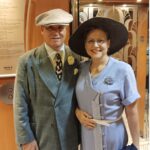
Mike and Mary began dancing in 1999 and quickly discovered their true love was the original swing dances of the 1930’s and 40’s big band swing-era: Lindy Hop and Balboa.
How did we get started in swing dancing? See the info below.
Mike and Mary began dancing in 1999 and quickly discovered their true love was the original swing dances of the 1930’s and 40’s big band swing-era: Lindy Hop and Balboa.
How did we get started in 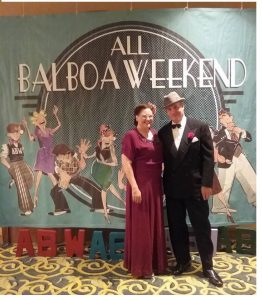 swing dancing? For Mike, he wanted to fulfill a promise to Mary, and a lifelong personal desire, to learn to dance. As a youngster, Mike often listened to “oldies” radio stations, which in those days consisted of a fair amount of big band and jump blues genres of music, which furthered his interests in the dances associated with that music. Mike is especially partial to the music of the Big Band / WWII Swing-era and sees the Hepcats promotion of Lindy Hop and Balboa as another way to honor veterans from that era.
swing dancing? For Mike, he wanted to fulfill a promise to Mary, and a lifelong personal desire, to learn to dance. As a youngster, Mike often listened to “oldies” radio stations, which in those days consisted of a fair amount of big band and jump blues genres of music, which furthered his interests in the dances associated with that music. Mike is especially partial to the music of the Big Band / WWII Swing-era and sees the Hepcats promotion of Lindy Hop and Balboa as another way to honor veterans from that era.
For Mary, her musical theatre background and love of swing-era music, movies, fashion and clothes is the catalyst for her creativity, not only as an instructor and on the social dance floor, but as a choreographer for the Hepcats Rhythm Cats and Razz Ma Tazz performance groups.
Back to 1999. Unable to find any instruction in Lindy Hop or Balboa in the Lexington area, Mike & Mary began to teach themselves, view vintage films and movies, and attend regional and national level workshops and competitions. By 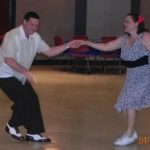 attending Lindy Hop and Balboa events all over the U.S., they have taken lessons and learned from many of the best instructors (and a few of the original swing dancers!) in the Lindy Hop / Balboa swing dance community. They also offer a unique perspective for newer/beginner swing dancers as they have witnessed the development and growth of the “modern” era of swing dancing, at the local, regional and national level.
attending Lindy Hop and Balboa events all over the U.S., they have taken lessons and learned from many of the best instructors (and a few of the original swing dancers!) in the Lindy Hop / Balboa swing dance community. They also offer a unique perspective for newer/beginner swing dancers as they have witnessed the development and growth of the “modern” era of swing dancing, at the local, regional and national level.
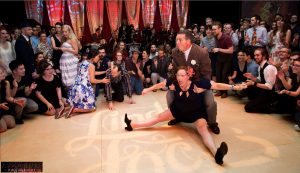
Mike & Mary have been instrumental in establishing and developing the Lindy Hop and Balboa swing dance scene in Lexington and central Kentucky, and 2025 marks the 25th year they’ve been promoting Lindy Hop and Balboa. They consider it a privilege and an honor to contribute to the great tradition of the dances and music of the swing-era.
Lindy Hop and Balboa have a rich history and culture, and Mike & Mary believe an understanding and appreciation for that history and culture is important for Lindy Hop and Balboa swing dancers. As the saying goes “If you don’t care where you’re going, any road will get you there.” So they strive to not only teach and promote Lindy Hop and Balboa, but also educate and preserve the great dances of the swing-era.
Why Take Lessons From Us?
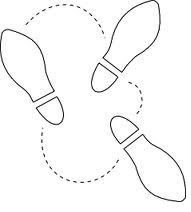 Mike & Mary have taught swing dancing for over 25 years and are the most knowledgeable and experienced swing dance instructors in the Lexington/central Kentucky area. Not only have they taught literally thousands of people to dance, they’ve taught at numerous local and regional swing dance workshops and events. Their teaching style is based on learning, laughter and fun!
Mike & Mary have taught swing dancing for over 25 years and are the most knowledgeable and experienced swing dance instructors in the Lexington/central Kentucky area. Not only have they taught literally thousands of people to dance, they’ve taught at numerous local and regional swing dance workshops and events. Their teaching style is based on learning, laughter and fun!
They believe that solid fundamentals in movement, connection and technique are key in partnered swing dancing. They break down individual steps and patterns in an easy, step-by-step manner that allows each student to learn the material and understand how it works.
If you’re a beginner, Mike & Mary’s teaching style will provide you that initial solid foundation and self-confidence so you can shine on the dance floor! You’ll also develop the skills necessary to continue to learn more intermediate/advanced steps and patterns. For swing dancers with more experience, Mike & Mary can help you take your dancing to the next level, to include learning more complicated material, developing musicality in your dancing, and even preparing for competitions.
It’s a journey, not a destination!
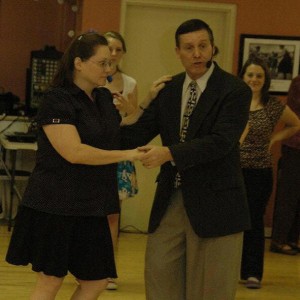 Mike & Mary don’t just “dabble” in swing dancing: they love the dances and they study the dances. They believe that learning to swing dance is a journey, not a destination. They have travelled to out-of-town swing dance workshop events such as the All Balboa Weekend (ABW), Camp Hollywood, American Lindy Hop Championships, Lindy Focus and the International Lindy Hop Championships to take workshop classes, private lessons and compete to further hone their skills. They also encourage Lindy Hop and Balboa swing dancers to participate in competition activities as a way to they improve their skill level.
Mike & Mary don’t just “dabble” in swing dancing: they love the dances and they study the dances. They believe that learning to swing dance is a journey, not a destination. They have travelled to out-of-town swing dance workshop events such as the All Balboa Weekend (ABW), Camp Hollywood, American Lindy Hop Championships, Lindy Focus and the International Lindy Hop Championships to take workshop classes, private lessons and compete to further hone their skills. They also encourage Lindy Hop and Balboa swing dancers to participate in competition activities as a way to they improve their skill level.
As far as competitions, Mike & Mary believe that competition type activities (of course, friendly and fun competitions) are beneficial to helping improve any Lindy Hop/Balboa swing dancer. One of the best ways for an individual to take their swing dancing to the next level is to participate in a performance group, in jam circles, in a couples or jack & jill contest, etc. These activities get the competitive juices flowing and are often the catalyst for individual improvement. We also believe that competition type activities, especially performance group activities, are one of the signs of a healthy and growing swing dance scene.
Mike & Mary have competed in more competitions than they can remember! And they’ve been fortunate to have placed, and even won their fair share of competitions. Some of their more memorable competitions include the All Balboa Weekend; Camp Hollywood; All Balboa Camp Detroit; the American Lindy Hop Championships; the Dayton Swing Smackdown; and of course, lots and lots of competitions at local and regional events.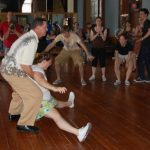
Mike & Mary are passionate about sharing all the great things about swing dancing, and swing music! Check out our web site for information on classes, private lessons and dance events. Don’t hesitate to contact us at 859-420-2426, or email, info@luv2swingdance.com if you have any questions or need any information. And don’t forget to subscribe to the Hepcats Newsletter to stay up-to-date on Hepcats activities.
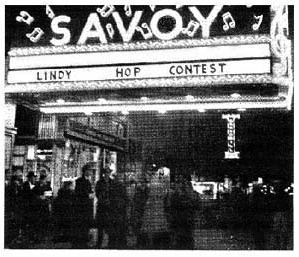
Mike & Mary have been instrumental in establishing and developing the swing dance scene in Lexington and central Kentucky, and 2026 marks the 24th year they’ve been promoting Lindy Hop and Balboa. They consider it a privilege and a honor to contribute to the great tradition of those dances and the great music of the swing-era.
Keepin’ it real! Mike & Mary strongly believe awareness of and an appreciation for the swing-era as a historical and cultural asset is important for the Lindy Hop and Balboa dancer. In order to know where you’re going, you have to know where you’ve been!
Some of the highlights of the past 20+ years that come to mind:
o Teaching the original swing-era dances, Lindy Hop and Balboa, to literally thousands of people. It’s a real joy to see the moment when the “light comes on” for a new student; or when a “step, step, rock step” swing dancer takes on the challenge to learn Lindy Hop; or when someone discovers the unique and dynamic nature of Balboa!
o Providing swing dances in Lexington at venues where people can dance to the great music of the swing era.
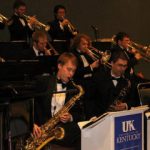

o Collaborating with the Kentucky Jazz Repertory Orchestra (KJRO) to provide music for big band swing dances from authentic swing-era arrangements. One of two ensembles provide the music for these events: (a) KJRO, consisting of the finest and most talented faculty, alumni and musicians from Kentucky area colleges and universities; or (b) the UK Jazz Ensemble (UKJE), consisting of the most talented students in the award winning and nationally recognized UK Jazz Studies Program.
The dancers obviously benefit from these events, but so do the musicians as they get a chance to see some authentic Lindy Hop and Balboa danced to the great music they play. Not many (if any) communities the size of Lexington have swing dances with such talented big band orchestra’s providing authentic, swing-era music!

o The establishment of Lindy Hop performance groups to elevate the level of swing dancing in Lexington and central Kentucky. These performance groups experienced success at regional and national level competitions and events. And most of those dancers got their start with Mike & Mary and the Hepcats!
o Collaborating with other organizations in Lexington/central Kentucky to bring high quality swing dance events to Lexington, i.e. Swingin’ On Main, Lexington’s annual outdoor swing dance. Mike & Mary have assisted with this event for over 20+ years. Mike is responsible for selecting the band that provides the music, and Mike and Mary are judges for the dance contest.
o Sponsoring one day and weekend workshops, some featuring high quality national and regional level Lindy Hop and Balboa instructors.
Once again, thank you for your support, and see you on the dance floor!
Keepin’ it real! The Hepcats get lots of compliments on the DJ and live music played at Hepcats events. Of course, the real credit goes to the artists that recorded the song, and the musicians in the bands. But let’s take a few moments to get to know a little bit about the person that DJ’s the music for Hepcats events – Mike Richardson.
Mike’s love of swing dancing naturally meshed with his love for the great music of the swing-era. He believes you can’t separate the dance from the music – we dance the great swing-era dances Lindy Hop and Balboa – and the music for those dances should reflect the same!
The great big band swing music of the swing-era is definitely Mike’s favorite genre of music, both personally, and for playing at swing dances. He also is also fond of the jump blues genre. Within those general parameters, Mike’s philosophy on DJing for Hepcats events is to play great swing music that will make people want to get up and dance. You’ll hear a variety of songs at a variety of tempos from Mike’s collection of over 10,000 songs (and you may also hear some surprises!).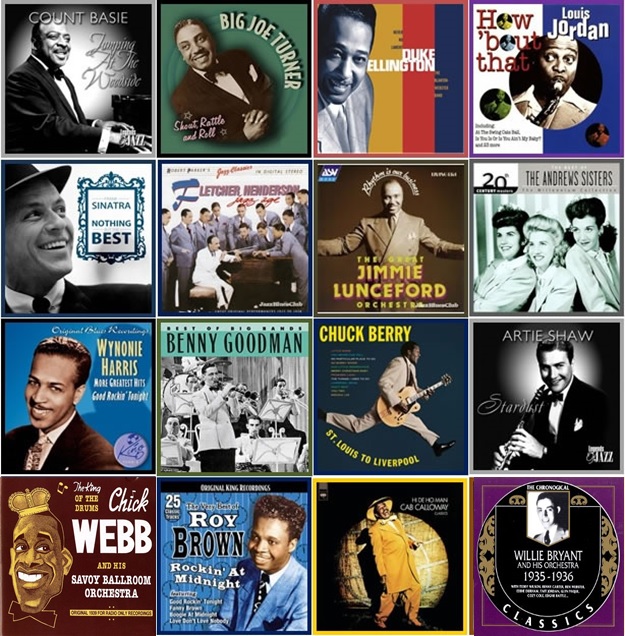
Mike is a member of the baby boomer generation, so how did he get interested in 1930’s and 40’s swing-era music?
As a youngster growing up Mike often listened to “oldies” radio stations, which in those days consisted of a fair amount of big band and jump blues genres of music. The “popular” music of Mike’s youth was the sound of Motown and Stax records (and he will occasionally spin a tune from that era of music). But his first love is the classic big band and jump blues music of the swing-era!
Mike has DJ’d at numerous local, regional and national level swing dance events, to include events in Lexington, Cincinnati, Columbus, Louisville, and Chicago. He’s been invited to DJ at other regional and national events, but primarily due to time demands and family considerations (I enjoy spending time with my grand children!) he has not been able to commit to those events, but maybe in the future! He has also DJ’d at several weddings, mostly for swing dancers tying the knot!
Mike is more than happy to share his knowledge about swing music, and he is always open to take requests. And lastly, don’t forget it’s okay to ask Mike to dance – just because he’s DJing doesn’t mean he doesn’t want to dance!
Hope to see you at a future Hepcats event!
For those interested in more information and details on Mike’s methods, ideas and philosophy on DJing for swing dances, see the accordion below: “Mike’s Way – The Swing Dance DJ”.
The DJ and the swing dance scene – Keep it Real!
It goes without saying that the DJ has a tremendous influence on that particular swing dance scene…or is that statement as obvious as it seems?
Could a swing dance scene develop good Balboa dancers if the DJ didn’t play music appropriate for Balboa? (Of course, if the DJ is not proficient at dancing Balboa, then that DJ probably doesn’t know much about good Balboa music.) If the DJ(s) plays mostly slow music, how will the swing dancers in that scene develop? How will the scene develop if the DJ plays mostly non-swing music?
All good questions, worthy of consideration and thought.
What makes a good Swing Dance DJ?
What makes a “good” DJ? In some ways, it shouldn’t be that important. Most people just want to go to a dance, have a good time, and dance to good music. And that’s okay; when I go to a dance, that’s what I want to do! It’s not surprising that few people appreciate the knowledge and expertise required to be a good DJ.
In fact, I’ve found that most swing dancers, from beginner to more experienced, and even those that “occasionally” DJ dances, have little or no idea on what it takes to be a “good” DJ: i.e. how to incorporate variety, flow, and contrast into a dance event, how to keep dancers of all ability levels happy, etc, etc, …..For those interested in the methods to my madness on this subject (or for the hardy soul thinking about taking on DJ duties), this information is for you.
Note: (1) This info is not intended to criticize any particular swing dancer, swing dance DJ or swing dance organization, but help bring more awareness to what should be the cornerstone of swing dancing: the music!
(2) This info is also obviously intended for those dancers/DJs in the Swing Dance Community. I’ve found that most “party”, “regular” or so called “professional” DJs have an appalling lack of knowledge about even the most basic elements of good swing music. Just because you’ve got Jump, Jive & Wail and Zoot Suit Riot (along with the Electric Slide) doesn’t mean you got good swing music. Sorry.
I believe a DJ at a Swing Dance should play….Swing Music!
I’ve traveled to lots of different swing dance scenes throughout the United States. I’m just not a big fan of scenes that play a lot of “non” swing music. I’m a swing-era Lindy Hopper and Balboa swing dancer and I like to dance to the great music of the swing-era for those great dances – it’s really that simple.
Play music that will make people want to get up and dance – you’re not playing for yourself!
Sounds simple. Seems obvious. Most people would agree that a DJ’s primary purpose is to play music that will make people want to get up and dance. But I can’t count the number of swing dances I’ve been to where the DJ was playing only one or maybe two type genres of swing music, most of it at the same tempo. There was no energy among the dancers or in the crowd in general. The people that were dancing were mostly going through the motions; or those not dancing were waiting for the next “same ole song”. The DJ seemed to be in his/her own little world. To the obliviously content DJ, everybody must be happy and having a good time, because the DJ was enjoying playing “his/her” music. If the DJ is happy, shouldn’t everybody else be the same? Ugh.
How to educate the scene about great swing music. As previously noted, it goes without saying that the DJ has a tremendous influence on that particular swing dance scene. So a good DJ can really educate the dancers about all the great music from the swing-era. But be careful…I once attended a dance where the DJ had just “discovered” 1950’s Be Bop jazz and wanted to “educate” everyone about that genre of music. Having to endure an entire set of 1950’s Be Bop jazz was not fun. Generally speaking, have a variety of songs for your playlist, those that are tried and true, and a few new ones you want to try out. If you want to discuss this topic more, feel free to contact me.
Good DJs are lifelong learners, always adding new songs to their collections. Indeed, there are lots of great songs “out there”, with some real gems undoubtedly waiting to be discovered. For a DJ, it’s a really good feeling to find a new song you were previously unaware of that turns out to be great for dancing.
Non-dancers in the crowd. It should not be forgotten there are often some non-dancers (or brand new beginning dancers) in the crowd at swing dance events. Great swing music played at events allows non-dancers to have a good time and perhaps spark their interest in swing music and swing dancing. (Good swing music also helps “hook” the beginning dancer.) A lot of people will start taking swing dance lessons because of the high energy swing music they hear at swing dance events.
“You’ve got to know the territory”
Knowledge about swing music genres. A DJ needs to have a certain amount of knowledge of the many different types and genres of swing music, and of course, have the actual music on hand to play (although no DJ could possibly have every swing song ever recorded!). A DJ must have a feel for swing music genres and specific songs in order to provide a good variety of tempo, flow and contrast in the music selection. A DJ has to understand the differences and nuances of the many varieties of good swing music: 1920’s and 30’s “pre-swing” swing music; classic 1930’s and 40’s Big Band; 1940’s and early 50’s Big Band; Jump Blues, early Rhythm & Blues, etc, etc…
Music for both Lindy Hop and Balboa. A good DJ will have a feel for and play music for both Lindy Hop and Balboa dancers. Granted, if a DJ is not a proficient Balboa dancer, that DJ may not understand what is considered good Balboa songs. Too many times I’ve asked a DJ to play a good Balboa song and what you get is something really fast, but not necessarily good for Balboa. If you’re not proficient in Balboa, talk to a good Balboa dancer that also DJs and get some advice from them on good Balboa music.
Beats Per Minute (BPM). A good DJ will know the beats per minute (bpm) of the songs they play in order to ensure they have a balance of tempos in the music selection. (There is lots of free software on the web that calculates BPM.) Let’s not get too technical: we all know that tempo is the speed of music. BPM is the unit used to measure the tempo or speed of music, i.e. how fast the song is played. Ever to been to a dance where the DJ seem to play a bunch of fast songs all right in a row, followed by a bunch of slow songs, all right in a row. Maybe you said to yourself, “Why couldn’t the DJ mix it up a little?”
I’ve known some DJ’s to say “I don’t need to know the actual BPM, I can get a feel or estimate for that from my knowledge of the song.” In my experience, that doesn’t work real well.
On occasion, I’ve asked DJs (and experienced swing dancers) to estimate the BPM of some very well known songs often played at swing dances. Their answers were almost always wrong, sometimes by as much as 25-100%! The estimations were normally on the low side, i.e. a song that was actually 175 BPM was estimated to be 140 BPM, etc.
The bottom line is that as a DJ, if you don’t know the BPM of the songs you’re playing, you can’t do your job properly.
Plan, Prepare, Execute
No, it’s not a military operation, but a DJ needs to do a little planning and preparation before the dance.
Plan. What will be the general audience for the dance? What type of venue? What will be the ability level of most of the dancers? Regardless of the audience, a DJ should always keep the music upbeat and energetic. As noted above, as Balboa becomes even more and more popular in the swing dance community, really good, hard swinging songs with faster tempos should be played for the Balboa dancers in the crowd.
In other words, know your audience; and keep in mind that the vast majority of people prefer variety. As they say, variety is the spice of life.
Prepare-the Music. I prepare a Playlist with specific songs already selected before each dance I DJ. For every dance I’ve DJed, I’ve always varied from that model to some degree. For example, I might choose not to play a certain song at that point in the dance, or I might want a song that’s faster, or slower, or a different genre, etc.
But having a model gives me a good starting point and ensures that variety, flow and contrast is built into the Playlist. So rather than try to “wing it” at the dance, I think it’s best for a DJ to prepare a Playlist beforehand and then make adjustments as necessary.
Prepare-the Sound System. Make sure you know how to operate the sound system, whether it’s the facility’s sound system or a system you set up. I’ve been to some Swing Dances where the DJ shows up about 10 minutes before the dance is supposed to start, and then spends the next half hour trying to figure out how the sound system works. That is un-good.
Execute-Punctuality is important. Start playing the music when the dance is scheduled to start. If there’s a pre-dance lesson that goes over it’s allotted time, there’s not much you can do (unless you were the instructor!).
Execute-Taking requests. I generally try to play requests if I have the song and, most importantly, the song will fit into the overall flow of the playlist.
Keep variety, flow and contrast in mind
Perhaps the toughest job for a DJ is to ensure that, along with variety of tempos and genres, there is also the proper amount of flow and contrast in the Playlist.
A DJ should not want the entire Playlist, or even large portions of the Playlist, to sound similar. If a lot of the songs in a Playlist tend to flow, i.e. the BPM is raised or lowered too gradual, songs are played together that have a common sound, theme or genre, then the DJ ends up creating one big long, “flowing” song. Dancers end up thinking, “Didn’t I just dance to a song like that?” Therefore, flow must be balanced with contrast.
Contrast is that feeling you get when you hear a song that’s different from the last song and you say, “Wow, I’ve got to dance to that one!” By playing a variety of genres and keeping flow and contrast balanced, you can keep the dancers inspired and dancing song after song. They end up leaving the dance happy, with a gentle feeling of fatigue, but ready and eager to come back for the next dance!
A note on specific song selections. In general, I try to keep the songs I play under 4 minutes. Dancing is a social activity. If the songs are too long, that means the dancers will not be able to dance with as many people throughout the event. In addition, the longer songs tend to be of a slower tempo and tend to have lots of instrumental solos, which can lead to the dancing becoming introverted and overcooked. And that can sap the energy right out of a dance event.
Depth in the playlist/your music collection. Keep in mind that it is possible to have a certain amount of variety, flow and contrast in your playlist, but your music selections could still lack depth.
Depth in a music collection is just what it implies. For example, if the “variety” of the selections for your Big Band songs is from Glenn Miller, Les Brown and Tommy Dorsey, then you don’t have depth (and you’re probably not very knowledgeable about big band music).
It is almost impossible to obtain depth in your music collection if your primary source of music is “free” or shareware downloads from the internet. If you want to be a good swing dance DJ with depth in your music, then you’re going to have to spend some bucks and purchase good music. The vast majority of really good swing dance music cannot be obtained for free on the internet (for a variety of reasons).
My three basic guidelines
Of course, a DJ is just like any other person, with certain preferences and areas of emphasis in their music collection. The information below is provided so you may get an idea about what factors I consider when developing a Playlist for a swing dance. I have three basic guidelines I use when developing and choosing songs for a Playlist.
(1) Variety and balance is key. That means variety in both musical tempos and musical genres/styles and balance in flow and contrast of the songs.
Unless one is DJing a special type swing dance (i.e. a Balboa event), the dominance of a narrow music tempo or of one music genre over another creates problems.
For example, some dancers like to dance to “slower”, “groovier” or “bluesey” type music (I’m not one of those dancers, by the way). Since the music is so slow, it’s much easier for these dancers to display their dance moves, and cover up their bad technique. However, if too much “groove” or “slow” or “bluesey” type music is played at a dance, the dance soon lacks energy and the dancing can quickly become introverted and overcooked and, quite frankly, the dance event becomes boring. That kind of quiet, subdued “groovy” feeling can be a real turn-off to many dancers, especially new and less experienced dances.
On the other hand, playing too much “fast” music also quickly becomes monotonous, and leaves dancers feeling drained and tired, especially for dancers that are not proficient in Balboa (or fast Lindy Hop technique).
As previously noted (but it bears repeating), a good variety of music played at a swing dance event allows non-dancers to have a good time and perhaps spark their interest in swing music and swing dancing. A lot of people will start taking swing dance lessons because of the high energy music they hear at swing dance events.
Indeed, when it comes to the music for swing dance events, it’s all about variety and balance!
(2) Does the song “swing”? I admit the definition of what is “swing” may certainly differ among people. For me, Swing is best described as the particular way a piece of music is played that gives it a certain vitality and energy. Note that I don’t necessarily equate “energy” with tempo. “Slow” songs can be energetic just as “fast” songs can be dull and boring.
Speaking of tempo, some people think that the tempo of the music is what basically defines whether it is good for dancing or not, i.e. that song is “too slow” or “too fast”, etc. I tend to disagree. I believe it is the underlying rhythmic feeling of swing music — that rhythmic pulse, that differentiates swing music from music that just happens to be in 4/4 time. In fact, there is a lot of music played in 4/4 time that people “swing dance” to, but that doesn’t make it swing music. (Go to a West Coast Swing, Ballroom, or a Bop Club event and you’ll see what I mean.)
Good swing music does not make you think, ponder, or scratch your head as you attempt to figure out how to interpret and dance to what you hear. With good swing music, you just want to get up and dance!
(3) Will the song make people want to get up and dance? As noted above, the energy from good swing music often comes from an underlying rhythmic pulse and feeling that makes you want to get up and dance. For some of the truly great swing songs, it’s almost impossible not to get up and dance!
My music preferences
Dislikes. I really don’t have any real dislikes. I keep an open mind when it comes to music for swing dancing. I’m willing to consider any type swing song(s) as long as it generally meets the three basic guidelines noted above. I do have a couple of preferences that may make me not play a song at a swing dance. As noted above, I’m generally not inclined to play songs that are over 4 minutes in length. I also generally like songs that have a full and energetic feeling about them. I’m not a big fan of songs that are “jazzy” and “smooth”, but don’t really swing (such as Trio type jazz songs, i.e. songs with only a Bass, Piano and Drums for instrumentation, etc).
Once again, I’m not saying I won’t play a song that’s over 4 minutes in length or one that’s really jazzy; it just has to be a really good song.
My Main Likes
My “likes” revolve around genres of swing music that I personally think should be genres of the majority of swing music played at swing dance venues. These genres of swing music also have a rich history in the development of swing dancing and swing music: (1) Swing-era Big Band (2) with a bit of Jump Blues and (3) a smattering of early Rhythm & Blues and early Rock & Roll.
Big Band
I like swing-era Big Band music. Most people have heard of the Big Band sound, a music style primarily from the 1930’s and 1940’s. Unfortunately, many people (even some swing dancers) associate the Big Band sound with the “champagne, mayonnaise and white bread” music of Lawrence Welk, the New Year’s Eve broadcasts of Guy Lombardo, or the commercially successful but stiff and bland music of Glenn Miller.
Simply put, the classic swing-era Big Band music is the music that was played as swing dancing, in the forms of Lindy Hop and Balboa, and big band jazz developed simultaneously in the U.S. in the 1930’s and 40’s.
Generally speaking, I think swing-era Big Band music should be well represented at swing dance venues. It sometimes seems one hears the same few Big Band songs played at various swing dance venues.
I believe there are a couple of reasons for this.
First, good, high quality recordings of Big Band music are not as well known and marketed as heavily as “mainstream” swing music. Of course, there are numerous Big Band recordings on the market; however a great many of these recordings have an inferior sound quality due to the recording technology (mono) of the 1930’s and 40’s. These CDs are often released by lesser known record labels that buy up rights to various versions of older big band songs. These record labels then release poor quality big band CDs or “collections” with no digital re-mastering and normally no liner notes. So, how does one find good quality big band music? There are two basic options: digital re-mastered versions of the original 1930’s and 40’s recordings, and 1950’s and 60’s Hi-Fi re-recordings/re-creations.
Digital re-mastered versions. Although it takes more searching and trail and error, there are some good songs out there from the 1930’s and 40’s that have been digitally re-mastered and have excellent sound. I don’t like to play a “scratchy” sound recording unless it’s a great song and I can’t find it in a better re-mastered version. The major music labels normally have the best re-mastered versions, although there are exceptions to that. Once again, stay away from the low-priced budget collections of big band music. They are almost always a waste of money.
Re-mastering tracks with your computer. If you really get into DJing, you’ll need to learn some basic programs that will allow you to “re-master” tracks on your own. It’s not hard to do, especially if I learned how to do it! Just something as basic as removing the hiss from a recording will often make the track sound a lot better.
Big Band re-recordings. With the advent of stereophonic Hi-Fi technology in the 1950’s and 60’s, many Big Bands re-recorded their standard numbers, primarily with Capital Records. These recordings were big hits when released as LPs in the 1950’s, 60’s and 70’s. Beginning in the mid 1990’s, many CD versions of these Big Band hits in Hi-Fi have been re-released. Like any CD, some go out of print, although they can often be purchased used. These CD recordings provide some good Big Band music for dancing (and listening!).
A second reason I believe more Big Band songs are not played at swing dance venues relates to music tempo. Many people are only familiar with a few of the well known Big Band classics that are on the fast side, such as “Sing, Sing, Sing” or “Jumpin’ at the Woodside”. While Big Band music is generally on the faster side, there are a lot of Big Band songs at a variety of tempos, both instrumentals and songs with vocals, that are really great for swing dancing.
Overall, I think Big Band music is the best genre of swing music that allows one to “transport” themselves back in time to the 1930’s and 40’s and get an appreciation for what it “may have been like” when dancing in that era.
One last note. There are some very good contemporary bands playing great swing music in the big band genre, such as the Kentucky Jazz Repertory Orchestra, the Glenn Crytzer Orchestra, the Jonathan Stout Orchestra, just to name a few.
Jump Blues
I’m not sure why more Jump Blues music is not played at swing dance events; it’s the most often neglected genre at swing dances. Jump Blues music is just a whole lot of fun to dance to! It was the bridge between the big band swing and jazz sound of the 1930’s and 40’s and the later rhythm and blues (R&B), primarily in a small band context.
Usually featuring a vocalist in front of a large, horn-driven orchestra or medium sized combo with multiple horns, the style is earmarked by a driving rhythm, intensely shouted vocals, and honking tenor saxophone solos, all of those very elements a precursor to rock & roll. The lyrics are almost always celebratory in nature, full of braggadocio and swagger. Lots of CDs by Jump Blues artists such as Louis Jordan, Big Joe Turner, Wynonie Harris, etc are readily available (man, if you don’t like to dance to music by Louis Jordan, Big Joe Turner, etc.: Jack, You Dead!). And Jump Blues is a genre that has lots of songs in a variety of tempos.
Late 1940’s/early 1950’s music
There is a lot of music from the late 1940’s and early 50’s that is great for swing dancing. Just a brief mention of a few genres.
Early Rhythm & Blues. Before it eventually metamorphosed into soul, early Rhythm & Blues music had a variety of artists that play some great music for swing dancing, such as Ray Charles and Ruth Brown.
Early Rock & Roll drew from a variety of sources, to include Jump Blues, Rhythm & Blues, country, gospel, traditional pop, and folk. All of these influences combined in a simple, blues-based song structure that was catchy and danceable: Bill Haley & the Comets and Chuck Berry immediately come to mind.
1950’s Rock & Roll music includes such artists as Little Richard, Jerry Lee Lewis, and even some early Elvis Presley.
History
A note on “history”. I believe it’s impossible to separate Lindy Hop and Balboa from swing music, from both a historical perspective and from the contemporary perspective of how the dancing and a swing dance community continually evolves.
I further believe that an understanding of the historical development of swing dancing and swing music has an inherent artistic and educational value that allows the dancer to better understand the rich culture of swing dancing and swing music and understand the context for their particular swing dancing style.
So make sure the music you DJ takes into account and contributes to that rich historial culture. If it was good enough for all those swing dancers of the swing-era, it should be good enough for us!
Misc. Info – DJing for a competition; sharing; compliments and complaints
DJing for a competition. If you’re DJing for a competition, the best rule to follow is to keep it simple and don’t get creative. Pick songs that really swing hard, but follow standard swing music phrasing. Remember, the competition is about the dancers dancing with each other to great swing music, and not about trying to figure out what kind of music the DJ is playing.
Share your expertise and information. Some people may be interested in particular songs you play, the name of the artist, etc. I’m always willing to share information with those interested in the music.
Compliments and Complaints. Be gracious when people compliment you on the music selection. Of course, a good DJ knows the real credit goes to the original artist of the song. Likewise, if someone has a complaint about the music and they offer constructive criticism, give it due consideration.
Of course, the bigger metropolitan areas have (or should have) a huge advantage – size does matter in this instance. For example, most swing dancers know that the Los Angeles, CA metro area (population about 12.9 million) and the Washington, DC metro area (population about 5.3 million) have regular opportunities for swing dancing to live music. Of course, the larger size crowds that the event attracts helps pay for the bands at those venues.
But it’s possible for even smaller towns and areas to get good live music in their scene. Mike & Mary live in the greater Lexington area of Kentucky, and Lexington is the second-largest city in Kentucky, the 66th largest in the U.S., with a city population of about 279,000 and a metro area (basically Fayette and surrounding counties) population of about 447,000. In spite of Lexington’s relatively small size, Mike & Mary/the Hepcats have been able to coordinate/assist with a good number of events with live music – good, high quality live music. How do we manage that?
Below are some practical tips and some opinions based on our experiences. A caveat: none of these comments are meant to be critical of any particular scene or musical organization, but are intended to bring more awareness to what should be the cornerstone of swing dancing: great music – both live and DJ!
 1. Get to know the bands in your area and their repertoire. One of the challenges of getting good live music for a swing dance is that there are not a lot of bands “out there” that know how to play for swing dancers. The genre of music the Hepcats prefer for most of our live music events, 1930’s/40’s big band swing, is not particularily easy for musicians to play (that’s what numerous musicians have told me). Scout out your area, talk to other swing dance organizers that book live music, and talk to band leaders and gauge their interest in playing for swing dancers. Without being overbearing, you’ll need to make sure the band understands your expectations (more on that later). Remember that for a lot of bands, their only experience in playing for “dancers” may have been at bars, concerts and music festivals.
1. Get to know the bands in your area and their repertoire. One of the challenges of getting good live music for a swing dance is that there are not a lot of bands “out there” that know how to play for swing dancers. The genre of music the Hepcats prefer for most of our live music events, 1930’s/40’s big band swing, is not particularily easy for musicians to play (that’s what numerous musicians have told me). Scout out your area, talk to other swing dance organizers that book live music, and talk to band leaders and gauge their interest in playing for swing dancers. Without being overbearing, you’ll need to make sure the band understands your expectations (more on that later). Remember that for a lot of bands, their only experience in playing for “dancers” may have been at bars, concerts and music festivals.
2. Jazz music is not necessarily good swing music. I’ve had a number of jazz musicians tell me that just because their band plays good “jazz” music, swing dancers (and by swing dancers I mean Lindy Hop and Balboa dancers) should welcome the oppoortunity to dance to their music. Sorry, but a lot of bands that play modern/contemporary “jazz” music just don’t play good swing music for swing dancers.
A band playing jazz music (or a band playing any kind of music) is not a juke box, able to play any type of genre of music on request. For instance, you wouldn’t expect a band playing post World 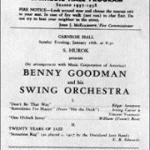 War II be-bop, or a band playing modern jazz to be able to play 1920’s Dixieland, 1930’s big band swing, or 1950’s rockbilly, etc…. In the same vein, jazz musicians shouldn’t expect Lindy Hoppers and Balboa dancers that thrive on 1930’s and 40’s big band music to dance to modern jazz. In both repescts, it’s two different things.
War II be-bop, or a band playing modern jazz to be able to play 1920’s Dixieland, 1930’s big band swing, or 1950’s rockbilly, etc…. In the same vein, jazz musicians shouldn’t expect Lindy Hoppers and Balboa dancers that thrive on 1930’s and 40’s big band music to dance to modern jazz. In both repescts, it’s two different things.
3. Don’t settle for mediocrity – this is really important. I’ve heard statements to the effect of “Even not so good live music is better than DJ music….” I beg to differ. For events with live music, events have to charge more for admission (vice an event with DJ music) in order to help pay for the band. People will expect a better “product” for that event, which is to be expected. If you sponsor an event with low quality music (or a band that plays a lot of “non swing” music), you’re going to turn people off, and the next time you have live music, even if you’ve upgraded the quality of the band, people will be leary of attending based on their past experience.
4. Don’t be cheap. If you want to hire a quality 16-17 piece big band, then hire the entire band. Don’t ask the band to only bring “9-10” musicians.
5. You get what you pay for. This is tied in with #4 above. When it comes to live music, you basically get what you pay for. If you want a high quality band to play for a swing dance, that’s not going to be cheap. Think about it – you’re not going to get a 16-17 piece big band with high quality musicians for $500 for the gig. Bands with talented, highly trained musicians that can play authentic swing-era genre type arrangements will want to be (and should be) paid accordingly. And if you pay the band appropriately, they should be willing to work with you to ensure the event is a success.
6. So you have a band in mind, how do you communicate your expectations and ensure the music will appeal to swing dancers?
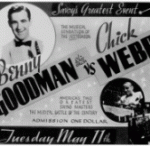 a. Coordinate the playlist with the band. Assuming the band has enough good arrangements in their “book” (see info below), let the band know what songs you want them to play, how long the songs should be, and at what tempo. In general you should ask the band to keep the songs at their original tempo and length (i.e. for length around 3 minutes or less). Make sure they understand this is a swing dance! I’ve done this for almost every band that has played for a Hepcats event and not a single band leader has objected to coordinating the playlist with me. (And if a band leader did object to coordinating the playlist with me, then I wouldn’t hire that band.)
a. Coordinate the playlist with the band. Assuming the band has enough good arrangements in their “book” (see info below), let the band know what songs you want them to play, how long the songs should be, and at what tempo. In general you should ask the band to keep the songs at their original tempo and length (i.e. for length around 3 minutes or less). Make sure they understand this is a swing dance! I’ve done this for almost every band that has played for a Hepcats event and not a single band leader has objected to coordinating the playlist with me. (And if a band leader did object to coordinating the playlist with me, then I wouldn’t hire that band.)
Quick story: I was at an out-of-town dance and heard a 17 piece big band play “Zoot Suit Riot” and “Rock this Town” at the event (and they were not good songs to dance to). I wondered why a 17 piece big band would even go to the trouble of obtaining those arrangements, take the time to rehearse them, etc. So I asked the band leader, “Why did you play those arrangements?” His answer was that he thought that’s what the dancers wanted: none of the event organizers had said anything to him about what to play, so he played what he thought people would want. Ugh.
b. Find out what is in the band’s “book”. Of course, to coordinate the playlist you’ll have to know what songs the band is capable of playing. Most bands will have list of the songs they play that is in their “book”. Most bands will not have a problem sharing that list with you.
So that’s it in a nutshell. I won’t go into the all the other things it takes to sponsor a swing dance with live music: facility set up, band arrival and set-up/rehearsal, acoustics, etc. If you’re interested in my views/experiences in those areas (or about this subject in general), feel free to contact me.
Thanks, and hope to see you at a future Hepcats event!
As some of you may know, Mike & Mary no longer work full-time, so we've been doing some traveling. Click here for info on that.
Why performance groups? The Hepcats believe competition type activities (of course, friendly and fun competitions), to include individual, couple, and performance group(s), are beneficial to helping improve any Lindy Hop/Balboa swing dancer. One of the best ways for an individual to take their swing dancing to the next level is to participate in a performance group, in jam circles, in a couples or jack & jill contest, etc.
These activities get the competitive juices flowing and are often the catalyst for individual improvement. The Hepcats also believe that performance group activities are one of the signs of a healthy and growing Lindy Hop/Balboa swing dance scene.
From 2008-2013, Mike & Mary via the Hepcats organized and sponsored numerous Lindy Hop performance group and competition type activities. For those interested in those activities and information, see below for more info.
Hepcats performance groups
◊ Mission: The mission of Hepcats performance groups is to provide a creative, fun and safe outlet for those swing dancers that want to participate in a Lindy Hop performance group, and take their Lindy Hop swing dancing to the next level.
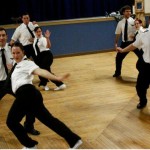
◊ Who participates? Participants in Hepcats performance groups normally include a diverse group of people (past participants have included all ages from college students to grandparents!), but we all have some things in common: a love of Lindy Hop; a desire to perform and share that love with others; and a desire to take our dancing to the next level.
The Rhythm Cats!
The Rhythm Cats is a Lindy Hop performance group sponsored by the Hepcats Swing Dance Club. Established by Mike & Mary Richardson via the Hepcats in 2008, the Rhythm Cats competed and performed in local, regional and national level competitions and events and consisted of the best Lindy Hoppers in the Lexington/central Kentucky area. And most of those dancers got their start with the Hepcats!
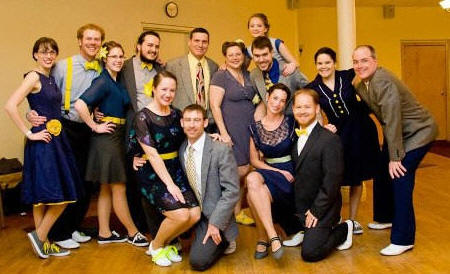
The Razz Ma Tazz!
At times the Hepcats sponsored a second performance group, the Razz Ma Tazz. The Razz Ma Tazz team members generally consisted of Hepcats performance group members with less competition and performing experience (although some Rhythm Cats members did fill in for a Razz Ma Tazz routine from time to time). Many Razz Ma Tazz members moved up to the Rhythm Cats after learning one or two Razz Ma Tazz routines.
What’s it like to put together / lead a performance group?
What’s it like to put together / lead /organize a Lindy Hop performance group? To summarize: the great times, the good times, the not so good times; the trials, the tribulations; the thrill of victory, the agony of defeat; the different personalities, and yes, sometimes the drama – – and that was only the first rehearsal!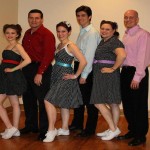
Overall, it was certainly enjoyable, and it was a big factor in raising the technique and level of expertise for Lindy Hop for all the participants.
Perhaps one day we’ll get our thoughts together and put down “on paper” more of the lessons learned, useful tips, pearls of wisdom, etc…..for organizing and leading a performance group. Check back, or feel free to contact Mike or Mary if you’re interested in that type of discussion.
Video Clips
Hepcats Swing Dance Club Performance Groups. As noted above, from 2008-2013, the Hepcats organized and sponsored Lindy Hop performance groups, primarily the Rhythm Cats, and occasionally the Razz Ma Tazz. Below are some videos of those groups.
o Rhythm Cats at Dayton Swing Smackdown, Feb. 23, 2013. The song is “Sing You Sinners”, by the Fletcher Henderson Orchestra, c. 200 bpm.
o Rhythm Cats at the American Lindy Hop Championships, Chicago, IL, May 2013. The song is “Sing You Sinners”, by the Fletcher Henderson Orchestra, c. 200 bpm.
o Rhythm Cats at Dayton Swing Smackdown, Feb. 25, 2012. The song is “Who ya Hunchin'”, by the Chick Webb Orchestra, c. 200 bpm.
o Rhythm Cats at the American Lindy Hop Championships (ALHC), Chicago, IL, May 2012. The song is “Who Ya Hunchin'”, by the Chick Webb Orchestra, c. 200 bpm.
o Rhythm Cats at Dayton Swing Smackdown, Feb. 26, 2011. The song is “Non Stop Flight”, by the Artie Shaw Orchestra, c. 203 bpm.
o Rhythm Cats perform at a Hepcats Big Band Swing Dance, Apr. 9, 2011. The song is “Non Stop Flight”, by the Artie Shaw Orchestra, c. 203 bpm.
o For the 2010 Dayton Swing Smackdown event, the Hepcats entered two groups.
oo Rhythm Cats at Dayton Swing Smackdown, Feb. 2010. Song is “Opus No. 1”, by the Tommy Dorsey Orchestra, c. 180 bpm.
oo Razz Ma Tazz at Dayton Swing Smackdown, Feb. 2010. This was an all-female group performance, with a 1920’s Charleston theme.
o Rhythm Cats at Dayton Swing Smackdokwn event, Feb. 2009. The song is “Lipstick, Powder, and Paint” by Big Joe Turner, c. 160 bpm.
I’m working on getting more links in this section for other video clips of Hepcats peformance groups, competition type activities, jam circles, etc. Check back……
Testimonials – what people say about Mike & Mary and the Hepcats.
“Thanks for the great music and the Lindy Hop demo – you and Mary should come back again soon!” A.B., Friday Night Fare at Wesley Village, Wilmore, KY, May 2023.
“You REALLY made the event special. A special thank you for all your support and all you do for KJRO!” Miles Osland, University of Kentucky (UK) School of Music, co-director of the Kentucky Jazz Repertory Orchestra (KJRO), Swingin’ at Sunset event, Keeneland Race Course, October 2009.
“Swingin’ on Main was amazing! Thank you for everything you do, and for organizing that event. You both are such great people with great hearts.” B.S., June 2013.
“Thank you for all the great instruction that you guys have given us over the years. The dance scene down here couldn’t exist without you two, and for that we are very grateful”. T.S., May 2009.
“Thank you for sharing your love, talent and knowledge with the students….Many of our students have said the class was already a highlight of their semester. We had a blast!” S.T., Oct. 2014.
“What you two are doing is fun, fun, fun! And we like it. Keep it up!” C.K., September 2011.
“I’m writing to thank you both for all of your encouragement and helping me become a swing dancer. I am so proud to be a part of the swing dance community along with the Rhythm Cats.” O.R., June 2009.
“Thank you for the effort that you put into teaching and promoting Lindy Hop. You guys do a fantastic job. Thank you for hosting the battle of the “Big Bands” last Saturday evening – a fabulous time was had by all.” H.C., April 2012.
“I’ve been to several Hepcats events, and had a blast! Thanks for putting on all of this great stuff for us!” A.D., January 2011.
“You guys ‘stole’ the show! I don’t know if you could hear the calls from the audience and their hand-clapping – but they really ‘dug’ you guys! We hope you will be back next year!” A.E., event organizer on the Rhythm Cats performance at the Lyric Theater, April 2011.
“You all did fantastic, and I got so many great compliments on your performance. I hope we can work with you again in the future!” C.M., event organizer for the Mr. University of Kentucky (UK) Pageant, October 2011.
“I wanted to thank you all for all your hard work putting the weekend events together. I had a really good time and learned a whole lot.” L.C., January 2012.
“Mike & Mary are able to break down the steps and explain things in a way that even I can understand! Thanks for the great classes.” C.A, January 2025.
“Hey Mike, we don’t need any of those national instructors…..we got you guys!” J.B., December 2009.
“In Recognition of Your Untiring and Selfless Contributions to the Lexington Swing Dance Community.” Hepcats 2009-2010 Performance Groups, the Rhythm Cats and Razz Ma Tazz, May 2010.
“Thank you both from me and many others as we enjoy the work of swing dance. It’s a neat part of the good life!” T.E., December 2011.
“Thank you for working with me and the Student Activities Board (SAB) for our dance program. I personally had a blast and received great feedback from other participants.” C.H., SAB Program Event Manager, November 2007.
“Appreciate all you do to keep the dance alive & kicking.” V.H., October 2011.
“Thank you for being a part of the Class Reunion. All the guests loved your dancing and the music was perfect for them.” G.B., University of Kentucky (UK) Class of 1958 Golden Reunion, October 2008.
“Thank you for providing excellent instruction and a fun atmosphere during the Hepcats lessons.” H.C., March 2012.
“I can’t thank you enough for the terrific evening you spent with us! Everyone had such a great time. You truly inspired all of us.” C.T., SCAPA Arts Facilitator, February 2010.
“Thanks for keeping swing dancing alive in Lexington and providing high quality dance events. Your efforts are really appreciated!” B.C., June 2008.
